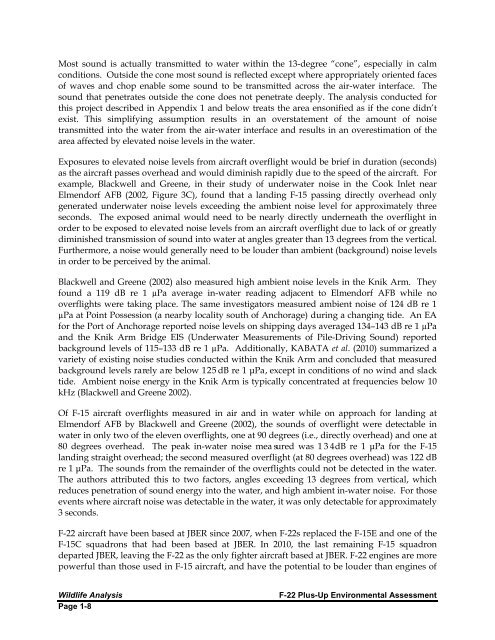F-22 Plus-Up Environmental Assessment - Joint Base Elmendorf ...
F-22 Plus-Up Environmental Assessment - Joint Base Elmendorf ...
F-22 Plus-Up Environmental Assessment - Joint Base Elmendorf ...
You also want an ePaper? Increase the reach of your titles
YUMPU automatically turns print PDFs into web optimized ePapers that Google loves.
Most sound is actually transmitted to water within the 13-degree “cone”, especially in calm<br />
conditions. Outside the cone most sound is reflected except where appropriately oriented faces<br />
of waves and chop enable some sound to be transmitted across the air-water interface. The<br />
sound that penetrates outside the cone does not penetrate deeply. The analysis conducted for<br />
this project described in Appendix 1 and below treats the area ensonified as if the cone didn’t<br />
exist. This simplifying assumption results in an overstatement of the amount of noise<br />
transmitted into the water from the air-water interface and results in an overestimation of the<br />
area affected by elevated noise levels in the water.<br />
Exposures to elevated noise levels from aircraft overflight would be brief in duration (seconds)<br />
as the aircraft passes overhead and would diminish rapidly due to the speed of the aircraft. For<br />
example, Blackwell and Greene, in their study of underwater noise in the Cook Inlet near<br />
<strong>Elmendorf</strong> AFB (2002, Figure 3C), found that a landing F-15 passing directly overhead only<br />
generated underwater noise levels exceeding the ambient noise level for approximately three<br />
seconds. The exposed animal would need to be nearly directly underneath the overflight in<br />
order to be exposed to elevated noise levels from an aircraft overflight due to lack of or greatly<br />
diminished transmission of sound into water at angles greater than 13 degrees from the vertical.<br />
Furthermore, a noise would generally need to be louder than ambient (background) noise levels<br />
in order to be perceived by the animal.<br />
Blackwell and Greene (2002) also measured high ambient noise levels in the Knik Arm. They<br />
found a 119 dB re 1 µPa average in-water reading adjacent to <strong>Elmendorf</strong> AFB while no<br />
overflights were taking place. The same investigators measured ambient noise of 124 dB re 1<br />
µPa at Point Possession (a nearby locality south of Anchorage) during a changing tide. An EA<br />
for the Port of Anchorage reported noise levels on shipping days averaged 134–143 dB re 1 µPa<br />
and the Knik Arm Bridge EIS (Underwater Measurements of Pile-Driving Sound) reported<br />
background levels of 115–133 dB re 1 µPa. Additionally, KABATA et al. (2010) summarized a<br />
variety of existing noise studies conducted within the Knik Arm and concluded that measured<br />
background levels rarely are below 125 dB re 1 μPa, except in conditions of no wind and slack<br />
tide. Ambient noise energy in the Knik Arm is typically concentrated at frequencies below 10<br />
kHz (Blackwell and Greene 2002).<br />
Of F-15 aircraft overflights measured in air and in water while on approach for landing at<br />
<strong>Elmendorf</strong> AFB by Blackwell and Greene (2002), the sounds of overflight were detectable in<br />
water in only two of the eleven overflights, one at 90 degrees (i.e., directly overhead) and one at<br />
80 degrees overhead. The peak in-water noise measured was 134dB re 1 μPa for the F-15<br />
landing straight overhead; the second measured overflight (at 80 degrees overhead) was 1<strong>22</strong> dB<br />
re 1 μPa. The sounds from the remainder of the overflights could not be detected in the water.<br />
The authors attributed this to two factors, angles exceeding 13 degrees from vertical, which<br />
reduces penetration of sound energy into the water, and high ambient in-water noise. For those<br />
events where aircraft noise was detectable in the water, it was only detectable for approximately<br />
3 seconds.<br />
F-<strong>22</strong> aircraft have been based at JBER since 2007, when F-<strong>22</strong>s replaced the F-15E and one of the<br />
F-15C squadrons that had been based at JBER. In 2010, the last remaining F-15 squadron<br />
departed JBER, leaving the F-<strong>22</strong> as the only fighter aircraft based at JBER. F-<strong>22</strong> engines are more<br />
powerful than those used in F-15 aircraft, and have the potential to be louder than engines of<br />
Wildlife Analysis<br />
Page 1-8<br />
F-<strong>22</strong> <strong>Plus</strong>-<strong>Up</strong> <strong>Environmental</strong> <strong>Assessment</strong>
















